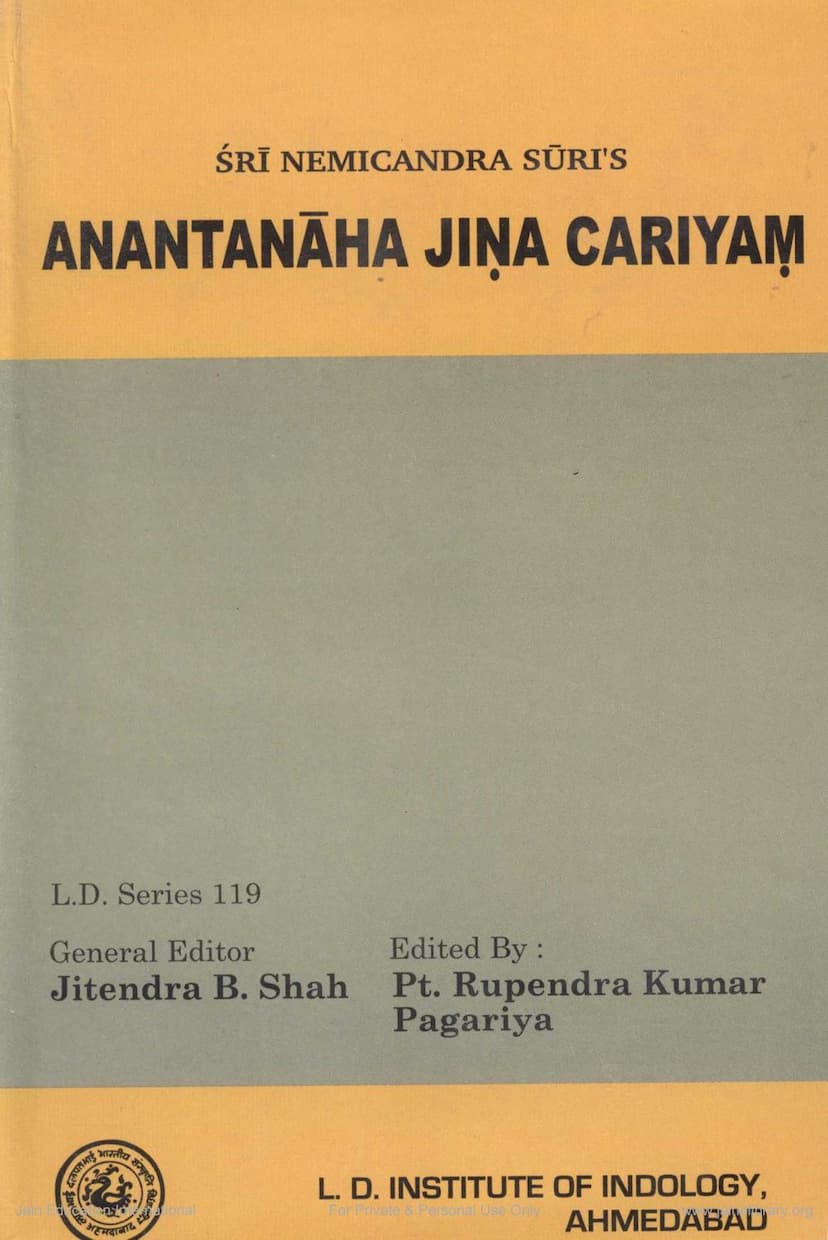Ananthnath Jina Chariyam
Added to library: September 1, 2025

Summary
The Jain text "Anantanatha Jina Chariyam" by Acarya Nemicandrasuri, edited by Pt. Rupendra Kumar Pagariya and published by L. D. Institute of Indology, Ahmedabad, is a biographical work detailing the life of the 14th Tirthankara, Lord Anantanatha. Composed in Prakrit, the text is based on a single surviving manuscript.
Acarya Nemicandrasuri, who lived in the 13th century, enriched the narrative with incidental stories meant to illustrate Jain tenets and reflect the contemporary socio-religious and cultural life. The editor, Pt. Rupendra Kumar Pagariya, is a respected scholar of Prakrit literature who has provided an exhaustive introduction in Hindi.
The book highlights the reverence and importance of Tirthankara life stories in Jainism, suggesting that reading them purifies sins. The "Anantanatha Jina Carita" narrates the holy life story of Jina Anantanatha, the 14th Tirthankara.
Key aspects and narrative:
- Mangal Shastra: The work begins with invocations to the first Tirthankara (Yugadi Jinendra), Lord Mahavir (Vardhaman Swami), Saraswati Devi, and several preceding Jains scholars and poets like Haribhadrasuri, Padaliptasuri, Bappabhattisuri, Abhaydevasuri, Hemchandrasuri, and Dhanpal.
- Analysis of Virtuous and Vicious Individuals: The text emphasizes the inherent nature of good and bad, stating that good cannot become bad, nor bad become good, much like day and night. It praises the ability of virtuous people to see the good even in flawed poetry.
- The Importance of Human Birth and Dharma: The work stresses the rarity and importance of a human birth, especially in a virtuous land and family. It advocates for the practice of Dharma after receiving the Guru's teachings, considering 'Gyandaan' (donation of knowledge) as the highest Dharma.
- The Life of Anantanatha: The narrative unfolds in five parts:
- First Life (Human Form): Lord Anantanatha's first existence as Prince Pratapratha in the city of Arishtapuri, son of King Padmaratha. The story includes his marriage to Princess Kamalavali, his rescue from the Vidyadhar Vijayketu, and his eventual renunciation and attainment of spiritual knowledge.
- Second Life (Divine Form): His rebirth as a powerful celestial being in the Pushpotara Viman in the Prana Vimaana, enjoying divine pleasures.
- Third Life (Birth as Tirthankara): His conception and birth as Anantanatha in Ayodhya. His parents were King Simhasena and Queen Sujasa. The text details the auspicious fourteen dreams of his mother, his name 'Ananta' (meaning infinite, chosen due to the mother's dreams of infinite garlands), his upbringing, marriage to various princesses including Madanavali, his reign of fifteen lakh years, and his eventual renunciation.
- Path to Omniscience and Teachings: The biography describes his austerities, enduring various hardships (Parishaha) for three years, leading to Kevala Jnana (omniscience) under an Ashoka tree. It elaborates on the Samavasarana (divine assembly), the composition of the Sangha, the appointment of Ganadharas, and the exposition of Dharma.
- Dharma Teachings: Lord Anantanatha's discourse covers the four types of Dharma: Dana (charity - knowledge, fearlessness, religious support), Sheel (virtuous conduct - 17 types including abstaining from violence, controlling senses, subduing anger), Tap (austerities - 12 types both external and internal), and Bhava Dharma (meditation - including Arta, Raudra, Dharma, and Shukla dhyana). The text uses illustrative stories to explain the merits of these practices, such as the tales of King Ranvikrama (on charity), Ratnavali (on virtue), Chandrakanta (on austerity), and Shringar Mukut (on meditation).
- The Eightfold Puja: The text also details the significance of the eightfold Puja (worship) using items like flowers, rice, fruits, water, incense, lamps, food offerings, and fragrances, with illustrative stories for each.
- Nirvana: The life story concludes with Lord Anantanatha's final journey to Mount Sammeta Shikhar, his month-long penance, and his liberation (Nirvana) along with seven thousand ascetics. His total lifespan is mentioned as thirty lakh Purva.
- Author's Tradition and Compositions: The preface to the text includes information about the author Acharya Nemicandra Suri's lineage within the Vadgachha tradition, his guru Parampara, and his other significant literary contributions like "Laghu Vir Charitra," "Uttaradhyayana Vritti," "Akhyanakamani Kosh," and "Ratnachuda." It also mentions the scholarly contributions of his disciples and the revision efforts by Acharya Yashodevsuri and Acharya Samantabhadrasuri.
- Literary Style: The work is praised for its blend of emotion, language, and artistic expression, often developing secondary characters more than the main protagonist. The descriptions of cities, nature, and rituals are vivid. The language is described as mature Maharashtri Prakrit, with influences from Sanskrit and the use of Ardhamagadhi Radda and Anushtup meters.
In essence, "Anantanatha Jina Chariyam" is a detailed and instructive biography of a Tirthankara, offering profound spiritual insights through engaging narratives and adhering to the Jain tradition of illustrating Dharma through exemplary lives.